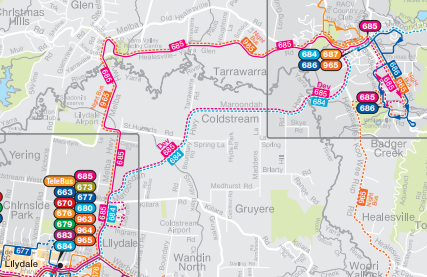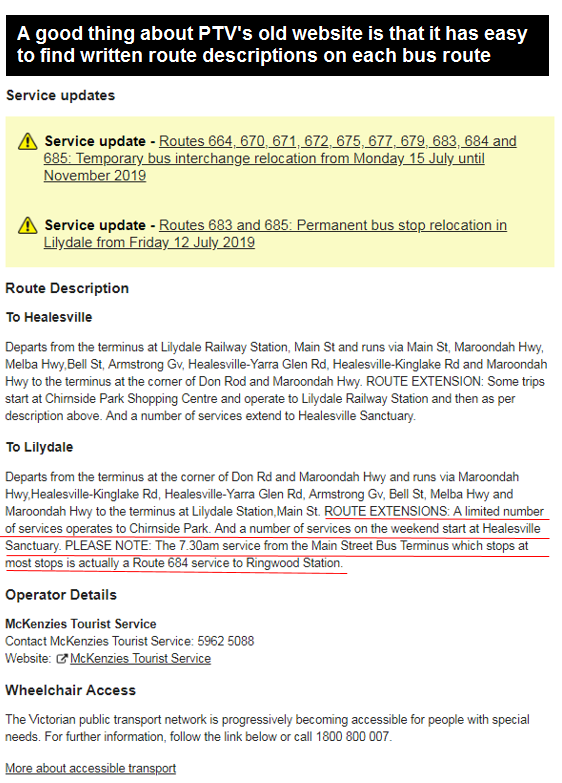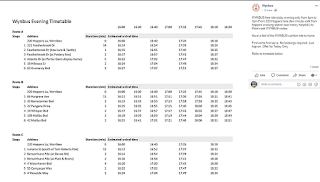Today we'll take a different tack. We'll go Melbourne wide. Today's we'll look at 12 links that are poorly served by the public transport network as it currently is. The latter point is important; these gaps don't have to be and it's only the limited pace of network modernisation that has kept them missing despite population growth and densification.
Not just any gap makes this list. Instead nominated routes need to be useful for diverse trip types throughout the day. And all would need to justify a 20 minute or better frequency during peak and off-peak periods in accordance with Useful Network standards.
Not just any gap makes this list. Instead nominated routes need to be useful for diverse trip types throughout the day. And all would need to justify a 20 minute or better frequency during peak and off-peak periods in accordance with Useful Network standards.
These are the sorts of network upgrades needed to get our buses to carry 200 million people per year instead of its current paltry 120-odd million. Or even to return to the 157 million trips it had in 1952/3 despite Melbourne then being a fraction of today's size and most people being near trains or trams.
Many won't be a surprise to regular Useful Network readers. Where I've previously covered it I'll link to the relevant item.
#1: Caulfield to Camberwell. Major centres, universities and rail junctions but no direct connection between them. It should really be a tram as we're only talking about 3km of extra track required on Burke Rd. But for now a bus will do. It's not quite the same corridor but you might be able to get some improved north-south connections by reforming Route 624. Potential exists to extend to La Trobe University as that's another missing link.
#2: Northern suburbs to Highpoint. Highpoint is a big shopping centre but it's only got good access from some directions. For example there's nothing crossing the Craigieburn line from the north-east to Highpoint. And the nearest thing to it, the route 468 from Essendon to Highpoint, has limited operating hours and no Sunday service, despite Sunday being a busy trading day. A way to cheaply resolve this and boost service to Highpoint could be to reroute the 903 SmartBus via Highpoint as per Useful Network Part 6.
#3: Cranbourne to Berwick. Berwick (especially 'old Berwick') has always been regarded as the 'jewel' in the outer south-east. It has private schools, private hospitals and even a university campus. But access from less endowed areas, including new estates not far to its south, has been lacking. The new 2016 Cranbourne network improved things but stopped short of introducing a direct Cranbourne - Berwick route. But urban growth is such that it's now needed.
#4: Sunshine to Melbourne Airport. Public transport travel from Sunshine to Melbourne Airport is excruciating. There's no less than two changes of vehicle. And because nothing is direct travel is slow. So slow that a fast runner from Sunshine to Tullamarine can beat public transport with over half an hour to spare.
Many other routes, whether it's trains from Geelong, Ballarat, Bendigo or Sunbury or buses from Caroline Springs, Altona North or Newport, pass through or terminate at Sunshine. Therefore if you don't have good airport transport at Sunshine you also aren't connecting these places very well to the airport. And we're talking about a catchment population close to 1 million, with fast growth projected.
It's easy to cut airport travel times from the west. All we need is a fastish bus from Sunshine to Melbourne Airport operating at a reasonable frequency over long hours. More discussion about this last week in Useful Network Part 17.
#5: La Trobe University to Camberwell. People in Melbourne sometimes define themselves by what side of the Yarra they live on. Although that's over-simplified; there seems little difference between the leafy streets and private schools of Ivanhoe and Hawthorn for example. When it comes to public transport though the difference is significant, with the northern side lacking all-day frequent train service. And crossing the Yarra can be difficult with two out of the four key bridges having only limited bus services.
One of these examples is Burke Rd with the route 548. That's a basic half-hourly service with limited operating hours and no Sunday service. It's got a useful northern terminus in La Trobe University. But its southern terminus is weak, finishing short of any train station. And the 548 misses Heidelberg despite its large number of jobs at nearby hospitals. Useful Network Part 15 tackles this by suggesting an upgraded 7-day service between La Trobe University, Heidelberg and Camberwell.
#6: Canterbury Rd. There's one medium size centre and some smaller attractions along it. But there's potential to connect into the large centres of Box Hill and Ringwood at the ends of a route. I'm talking about Canterbury Rd in Melbourne's eastern suburbs. It doesn't currently have a continuous bus, making many local trips slow and indirect. A direct bus would fix this. Useful Network #14 discusses this in detail.
#7: Nepean Hwy to Southland. This is one of those corridors, that, like Canterbury Rd, you'd think there would be a bus along there but there isn't. Well there sort of is in the 823 but it's only a very limited service and it veers off the highway before it can arrive at the area's strongest public transport terminus (Elsternwick).
A direct service could run along Nepean Hwy from Southland to Elsternwick. It could run 7 days per week and have a frequency boost from hourly on weekdays only to every 20 or 30 minutes. This service would provide far better connections to Southland than currently exist while providing a new train feeder to Elsternwick. Implementation would require network reform in the Brighton area to retain service on Dendy St.
#8: Chandler Hwy across the Yarra. This just has the very occasional Route 609 that doesn't go to anywhere useful for most people. However the area is densifying, with development of the old paper mill site. And there is a lack of north-south transport in the area.
My solution for the area, discussed in Useful Network 15, involves southern and northern extensions of Route 567 to form a simple and direct route between Hawthorn Station, Kew, Chandler Hwy, Fairfield Station, Northland Shopping Centre and La Trobe University. This would connect people to key local trip generators along with trains to the city.
#9: A Burnley St bus. When they stopped building cross-suburban trams cross-suburban bus routes were sometimes established instead. However these did not always last. Especially in wealthy suburbs that motorised early (eg the inner eastern suburbs) or (then) declining inner areas. Such a fate befell routes like 607, which until 1987 ran along Burnley St. That provided a convenient connection to trains at Burnely station at least during peak times.
Things have changed. The population decline has reversed. Units have gone up, housing students or CBD workers. And increasing car traffic has made trams slower than ever. So there might be merit in a Burnley St bus being restored to span a missing link in the grid.
Omitting a connection in a dense grid means access in only two directions, not three or four. For example Victoria Gardens is geographically constrained to the north and has no bus to the south. This causes it to have a very low SNAMUTS 'betweeness' rating - in other words it is difficult to reach from many surrounding centres. A bus to at least Burnley (which in itself has a much higher score) would improve Victoria Gardens' score.
Omitting a connection in a dense grid means access in only two directions, not three or four. For example Victoria Gardens is geographically constrained to the north and has no bus to the south. This causes it to have a very low SNAMUTS 'betweeness' rating - in other words it is difficult to reach from many surrounding centres. A bus to at least Burnley (which in itself has a much higher score) would improve Victoria Gardens' score.
What about connections from the St Kilda or Prahran area? Those are available from parts of Richmond near Hoddle St or Church St but not from parts further east. Potential exists for a Burnley St route to extend south down Williams Rd, going quite near Hawksburn Station. Such a service might be possible by operating the existing routes 216/219 via this alignment rather than doing as they currently do which is to overlap the 72 tram and terminate at the Alfred Hospital.
#10: Glen Iris to Caulfield via an extended 734. This is only a little extension. It wouldn't be on top of many peoples' minds. Especially if asked to write a 'top 12' list. However I see a lot of potential in it. Particularly given that the current terminus is so weak and the extension would only be a few kilometres.
A 734 extension (as discussed in Useful Network 3) would bring numerous network benefits. It would connect Monash University's Caulfield campus with a large catchment that despite its proximity is difficult to reach by public transport. Glen Iris, Ashburton, Ashwood and Mt Waverley for example. Other trips become easier due to improved connectivity between the Glen Waverley, Pakenham, Cranbourne and Frankston lines that this extension would enable. While by itself insufficient justification for a new bus route, the extension would also provide a back-up when trains fail or there are major works.
#11: Centre Rd, Clayton East. You're on a bus and it just stops. Others alighted before so it's just you and the driver. The driver looks around. "Last stop. I'm not going any further". How can this be? After all the road still continues as far as the eye can see. It's lined with buildings. And there's still plenty of traffic.
It's not as if buses in the area are not well used; with many jobs, densifying neighbourhoods and student share-houses existing routes get use to the point of crowding. The state government has earmarked the area as a 'national employment and innovation cluster' but hasn't backed it up with new or even reformed bus routes.
Welcome to Centre Rd, Clayton, the home of bus route 704. You can see where it peters out on the map below. Same place as it did in 1971. The terminus was once significant as it was the old Volkswagen factory, and, before then Martin & King, where trains were made. Volkswagen has long gone but, nearly 50 years later, the bus still terminates there. And 704's timetable in 2019 reflects its limited service industrial route heritage. Meanwhile development has continued, including a new 7-day home maker centre around the corner.
I've nominated Centre Rd east of Clayton as a missing link. Compare it to the western part of Centre Rd with six buses per hour, formed by the 703 SmartBus and the duplicative overlapping route 733. Due partly to its low frequency and partly because of its weak eastern terminus, the 704 is denied the opportunity to do something useful, like connect Waverley Gardens Shopping Centre and Clayton Station. Instead route 704 remains at its old terminus, despite a key reason that you might not consider it as an important route, the Centre Rd level crossing, recently being removed.
704 itself is not blameless in the duplication stakes. It overlaps other routes (including the 900 SmartBus) between Oakleigh and Huntingdale. If that was removed you could extend it eastwards to remove or lessen the Centre Rd gap. A further reform, likely involving the 631 and other local routes, could potentially provide the direct Waverley Gardens connection. That however would only be half-baked, unless one also looked at Westall Rd, another missing link, to provide it with a connection from Monash University to Keysborough via Westall Station.
#12: Southland to Sandringham via a rerouted 828. It's logical for buses to follow main roads unless there is a special reason why they can't. This allows maximum speed, directness and coverage. Whereas new stations in growth areas are typically accompanied by reforms to the surrounding bus network, this did not happen when Southland Station opened. Hence the local network (especially around Cheltenham) is unnecessarily complex and based on Southland not having rail access.
Southland Station offers opportunities to straighten buses in the area. Especially to Sandringham. Bay St has an employment area that would benefit from more direct access from the Frankston line. Also beneficial would be faster connections between lines when train services are suspended or replaced by buses due to works.
One possibility could be to swap Routes 822 and 828 so that the latter forms an east-west route across the south-eastern suburbs. The 828 is a well used route and already operates at a higher frequency than the 822 (20 vs 30 minutes on weekdays). Route 822 could operate via the existing 828 alignment so that stops are not missed. The map below gives an idea.
The above is a selection of 'missing links' in Melbourne's public transport network. What do you think? Are there any you'd add? Or do you think there's some here that wouldn't be well used? Either way please leave your comments below.
PS: Want to see expanded Useful Networks in other areas? An index to them all is here.












































